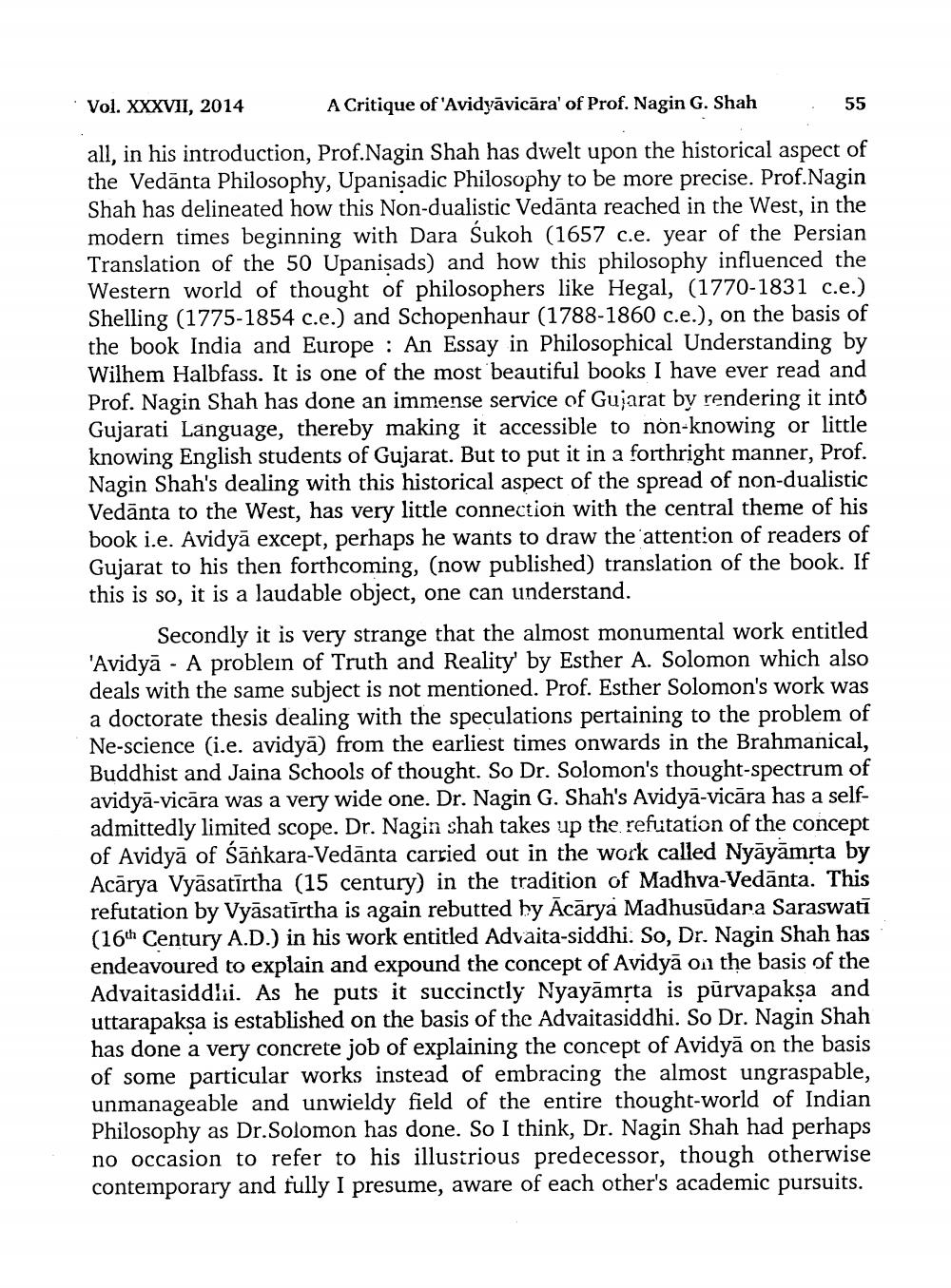________________
Vol. XXXVII, 2014
A Critique of 'Avidyāvicāra' of Prof. Nagin G. Shah
55
all, in his introduction, Prof.Nagin Shah has dwelt upon the historical aspect of the Vedānta Philosophy, Upanisadic Philosophy to be more precise. Prof.Nagin Shah has delineated how this Non-dualistic Vedānta reached in the West, in the modern times beginning with Dara Sukoh (1657 c.e. year of the Persian Translation of the 50 Upanisads) and how this philosophy influenced the Western world of thought of philosophers like Hegal, (1770-1831 c.e.) Shelling (1775-1854 c.e.) and Schopenhaur (1788-1860 с.e.), on the basis of the book India and Europe : An Essay in Philosophical Understanding by Wilhem Halbfass. It is one of the most beautiful books I have ever read and Prof. Nagin Shah has done an immense service of Gujarat by rendering it into Gujarati Language, thereby making it accessible to non-knowing or little knowing English students of Gujarat. But to put it in a forthright manner, Prof. Nagin Shah's dealing with this historical aspect of the spread of non-dualistic Vedānta to the West, has very little connection with the central theme of his book i.e. Avidyā except, perhaps he wants to draw the attention of readers of Gujarat to his then forthcoming, (now published) translation of the book. If this is so, it is a laudable object, one can understand.
Secondly it is very strange that the almost monumental work entitled 'Avidyā - A problein of Truth and Reality' by Esther A. Solomon which also deals with the same subject is not mentioned. Prof. Esther Solomon's work was a doctorate thesis dealing with the speculations pertaining to the problem of Ne-science (i.e. avidya) from the earliest times onwards in the Brahmanical, Buddhist and Jaina Schools of thought. So Dr. Solomon's thought-spectrum of avidyā-vicāra was a very wide one. Dr. Nagin G. Shah's Avidyā-vicāra has a self admittedly limited scope. Dr. Nagin shah takes up the refutation of the concept of Avidyā of Sankara-Vedānta carried out in the work called Nyāyāmsta by Acārya Vyāsatirtha (15 century) in the tradition of Madhva-Vedānta. This refutation by Vyāsatīrtha is again rebutted hy Ācārya Madhusudara Saraswati (16th Century A.D.) in his work entitled Advaita-siddhi. So, Dr. Nagin Shah has endeavoured to explain and expound the concept of Avidyā on the basis of the Advaitasiddhii. As he puts it succinctly Nyayāmsta is pūrvapaksa and uttarapaksa is established on the basis of the Advaitasiddhi. So Dr. Nagin Shah has done a very concrete job of explaining the concept of Avidyā on the basis of some particular works instead of embracing the almost ungraspable, unmanageable and unwieldy field of the entire thought-world of Indian Philosophy as Dr. Solomon has done. So I think, Dr. Nagin Shah had perhaps no occasion to refer to his illustrious predecessor, though otherwise contemporary and fully I presume, aware of each other's academic pursuits.




